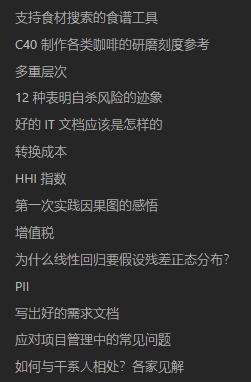The biggest role of a folder is resource isolation, similar to the namespace in C++. If you have a need to share, you can just throw the whole folder to others.
Maintain subdirectories
I have already talked about how I write various notes, but building a usable knowledge base is obviously not just about writing notes, because over time, the notes in the knowledge base will also accumulate, making it difficult to find notes in the file list, which is also a problem I have to face.

Imagine the length of this list being several times longer, which is probably the situation I once faced.
After trying many methods, I finally chose not to create a directory in advance, but to wait until the notes in a certain folder accumulate to a certain amount before creating it, that is, building the directory from the bottom up, because I found that doing so has two benefits for me:
- Save trouble: It is equivalent to triggering the directory update only when necessary, and will not waste part of the time like regularly maintaining the directory.
- Improve the efficiency of finding notes: The directories are all established according to my own cognition and understanding, so when I look for a specific note, I can quickly think of the corresponding directory location by recalling. In the early days, I also tried to refer to professional book classifications to build my own directory, but it could not well match my areas of concern, nor could it help me quickly recall the storage location of the notes, because I didn’t even understand some of the classifications myself.
Specifically, I did not set a precise amount of note accumulation to trigger a directory update, but more by feeling.
Every time I save a new note or browse the file list at will, I will glance at the number of notes at the same level within the visible range. If the number of notes has piled up to a level that I can’t stand at a glance, I will start to update the directory at this level.
I will quickly scan the titles of these notes, first get a general impression of their content, then choose a category that can include the most notes, create a new folder, and move the corresponding notes into it.
Most of the literature notes can rely on the original text type, source platform/author to establish subdirectories, but the permanent notes are all written in their own words, so it is best to have a customized directory, and the structure of the directory should not be too complicated, otherwise it will be a headache to find notes.

References
How I built a knowledge base that is convenient for finding notes and powerful for writing - sspai